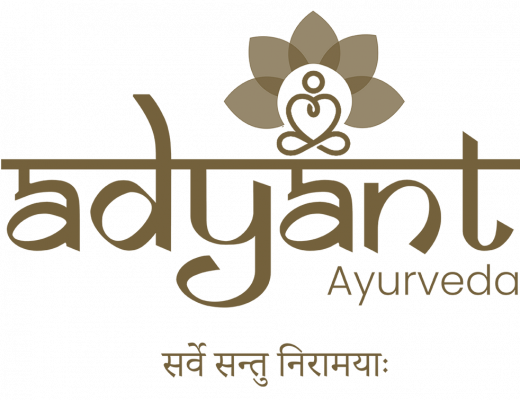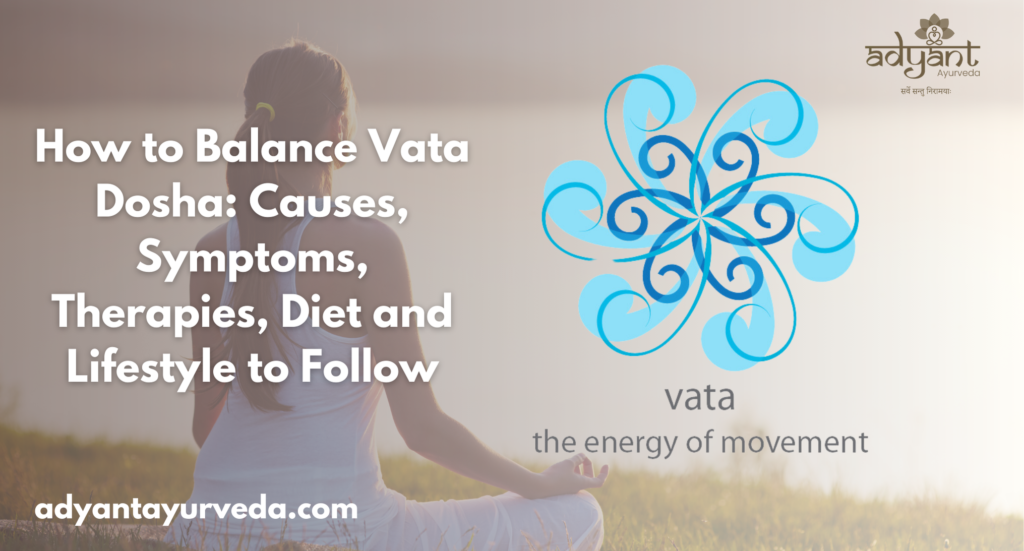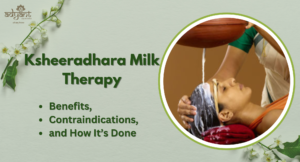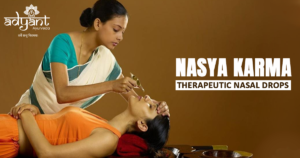Table of Contents
Toggle🔍 Introduction: Understanding Vata Dosha in Ayurveda
In Ayurveda, the ancient Indian science of life, the human body is governed by three fundamental energies or doshas: Vata, Pitta, and Kapha. Among these, Vata Dosha holds a unique and vital place. It governs movement in both the mind and body. When Vata is balanced, it fosters creativity, vitality, and adaptability. However, when imbalanced, it can lead to a host of physical and mental disturbances.
At Adyant Ayurveda, the National Award-winning Ayurvedic clinic in Bangalore, a holistic and individualized approach is used to treat Vata imbalances based on classical Ayurvedic principles.
💡 For a free consultation with top Ayurvedic doctors, download our app “AyurCare” from the Play Store.
📊 What is Vata Dosha?
Vata Dosha is made up of air and ether elements. It is characterized by qualities like:
-
Lightness
-
Dryness
-
Coldness
-
Mobility
-
Subtlety
It governs essential bodily functions such as:
-
Blood circulation
-
Nerve impulses
-
Breathing
-
Movement of thoughts and emotions
People with a dominant Vata constitution often show signs of enthusiasm, creativity, and quickness, but may also suffer from overactivity, anxiety, and dryness when imbalanced.
🚨 Diseases Caused by Vata Dosha Imbalance
When Vata Dosha becomes significantly aggravated, it can manifest into several health disorders, including:
-
Arthritis and joint pain
-
Sciatica
-
Insomnia
-
Constipation and IBS (Irritable Bowel Syndrome)
-
Dry skin and eczema
-
Menstrual irregularities
-
Anxiety and panic disorders
-
Neurological conditions like Parkinson’s
-
Lower back pain
Early recognition and timely Ayurvedic intervention help prevent chronic progression.
🩺 Symptoms of Vata Dosha Imbalance
Physical Symptoms
-
Dry skin and hair
-
Constipation and bloating
-
Cold hands and feet
-
Joint pain or stiffness
-
Irregular menstrual cycles
Mental Symptoms
-
Anxiety or restlessness
-
Insomnia
-
Difficulty concentrating
-
Overthinking
These imbalances are often worsened by:
-
Excessive travel
-
Irregular meals
-
Sleep deprivation
-
Cold weather
⚡ Causes of Vata Dosha Imbalance
Imbalances in Vata Dosha are frequently caused by modern lifestyle habits such as:
-
Skipping meals or eating cold/raw foods
-
Overworking or multitasking
-
Mental exhaustion and stress
-
Poor sleep hygiene
-
Excessive physical activity
-
Exposure to wind and cold climates
Recognizing these triggers is the first step to healing. At Adyant Ayurveda, practitioners focus on identifying these causes to create personalized healing protocols.
🍲 How to Balance Vata Dosha Naturally
🌿 Dietary Adjustments
To pacify Vata, Ayurveda recommends warm, moist, nourishing foods that counteract its dry and cold nature.
✅ Include:
-
Warm soups and stews
-
Ghee and healthy fats
-
Cooked grains (rice, oats)
-
Sweet, sour, and salty flavors
❌ Avoid:
-
Raw vegetables, salads
-
Dry snacks (crackers, chips)
-
Caffeinated or carbonated drinks
-
Alcohol
🏡 Lifestyle Modifications
-
Follow a routine for meals and sleep
-
Practice yoga and meditation to calm the mind
-
Use warm sesame oil for daily Abhyanga (oil massage)
-
Get adequate rest and avoid overstimulation
🏠 Natural Tips & Home Remedies for Vata Imbalance
In addition to herbs and lifestyle, try these simple and effective home remedies to calm Vata:
-
Warm water sipping: Keeps digestion strong and prevents dryness.
-
Spiced milk at night: Add nutmeg, cardamom, and ghee to warm milk before bed.
-
Foot massage with oil: Massaging feet before sleep reduces stress and improves sleep quality.
-
Soaked almonds: Consume 5–7 peeled, soaked almonds daily for strength.
-
Cook with Vata-friendly spices: Use cumin, fennel, ginger, and cinnamon.
-
Steam inhalation: Helpful for dryness and calming Vata in the respiratory channels.
-
Aromatic baths: Use essential oils like lavender, rose, or sandalwood in warm baths.
Practicing these natural habits regularly helps to restore and maintain Vata balance gently and effectively.
🌿 Ayurvedic Medicines for Vata Dosha
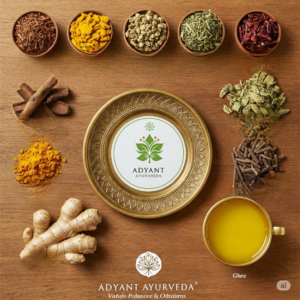
At Adyant Ayurveda, only pure and high-quality herbal formulations are used. Here are the most effective Ayurvedic medicines and herbs for pacifying Vata Dosha:
-
Ashwagandha (Withania somnifera):
-
For Vata: Grounding and calming, reduces stress and anxiety, improves sleep and vitality.
-
General: Adaptogen, boosts energy, cognition, and immune health.
-
-
Brahmi (Bacopa monnieri):
-
For Vata: Calms the nervous system, enhances focus and memory, reduces anxiety.
-
General: Brain tonic, supports cognitive health and skin.
-
-
Shatavari (Asparagus racemosus):
-
For Vata: Nourishes dryness, balances hormones, soothes the nervous system.
-
General: Supports reproductive and digestive health.
-
-
Triphala (Amalaki, Bibhitaki, Haritaki):
-
For Vata: Gentle laxative, supports detox, regulates digestion.
-
General: Detoxifies, rich in antioxidants, promotes gut health.
-
-
Ginger (Zingiber officinale):
-
For Vata: Warming improves digestion and circulation, reduces joint pain.
-
General: Anti-inflammatory, aids immunity, and relieves nausea.
-
-
Bala (Sida cordifolia):
-
For Vata: Strengthens the body, reduces fatigue, and joint pain.
-
General: Enhances stamina, supports the nervous system.
-
-
Jatamansi (Nardostachys jatamansi):
-
For Vata: Calming, helps with insomnia, anxiety, and mental restlessness.
-
General: Brain tonic, supports relaxation and hair health.
-
-
Ghee (Clarified Butter):
-
For Vata: Lubricates and nourishes tissues, supports digestion.
-
General: Enhances nutrient absorption, strengthens immunity.
-
🌱 Ayurvedic Therapies to Balance Vata
• Basti (Medicated Enema)
-
Most effective therapy for Vata disorders
-
Detoxifies and nourishes the colon
• Shirodhara
-
Warm oil was poured on the forehead
-
Calms the mind and supports the nervous system
• Abhyanga (Oil Massage)
-
Improves circulation
-
Lubricates joints and relieves stiffness
All therapies at Adyant Ayurveda are conducted by trained professionals in a healing environment.
⚙️ Vata Subtypes (Optional Deep-Dive for Advanced Readers)
-
Prana Vata: Governs mental activity, breathing, and head functions
-
Udana Vata: Controls speech and expression
-
Samana Vata: Located in the digestive system
-
Apana Vata: Deals with elimination, menstruation, childbirth
-
Vyana Vata: Circulates energy throughout the body
Each subtype is addressed uniquely during Ayurvedic consultation.
ℹ️ Why Consulting an Ayurvedic Doctor is Crucial
While home remedies and lifestyle changes are helpful, professional Ayurvedic diagnosis is essential to:
-
Assess your unique constitution (Prakriti)
-
Identify root causes of imbalance
-
Tailor herbal remedies and therapies to your needs
At Adyant Ayurveda, we focus on root-cause healing, ensuring long-term wellness rather than temporary relief.
🚨 Why Choose Adyant Ayurveda for Vata Dosha Management?
-
✔ National Award-Winning Ayurvedic Clinic in Bangalore
-
✔ Experienced Ayurvedic Doctors
-
✔ Personalized Treatments
-
✔ Pure, High-Quality Herbs & Oils
-
✔ Emphasis on Long-Term Healing
Whether you’re struggling with anxiety, joint stiffness, or insomnia due to Vata imbalance, Adyant Ayurveda is your holistic solution.
📍 Book your consultation now
📱 Download the “AyurCare” app from the Play Store
❓ FAQs on Vata Dosha and Its Ayurvedic Treatment
Q. What is Vata Dosha in Ayurveda?
A: It is one of the three doshas, composed of air and ether, responsible for movement and communication within the body.
Q. What are the signs of Vata imbalance?
A: Dry skin, anxiety, constipation, joint pain, restlessness, and poor sleep.
Q. How can I balance Vata naturally?
A: By eating warm, oily, nourishing food, maintaining a routine, practicing yoga, and using warm oil massages.
Q. What Ayurvedic therapies help in balancing Vata?
A: Basti, Abhyanga, and Shirodhara are most effective.
Q. Why is professional consultation important?
A: Ayurvedic Doctors offer customized treatment based on your unique constitution and health condition.
Q. Why Adyant Ayurveda?
A: We combine tradition with expertise to offer authentic and personalized Ayurvedic care.
📎 Related Ayurvedic Treatments
📝 Conclusion
Balancing Vata Dosha is vital for physical, emotional, and mental harmony. At Adyant Ayurveda, we blend the wisdom of classical Ayurveda with modern understanding to provide safe, natural, and effective healing.
Whether you’re facing chronic stress, digestive issues, or mobility concerns, restoring Vata balance is your key to lasting health.
📘 Begin your journey to wellness today with Adyant Ayurveda.
